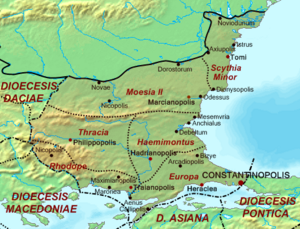Moesia

Moesia (
Geography
In ancient geographical sources, Moesia was bounded to the south by the
History
The region was inhabited chiefly by
Parts of Moesia belonged to the polity of Burebista, a Getae (Dacian) king who established his rule over a large part of the northern Balkans between 82 BC and 44 BC. He led plunder and conquest raids across Central and Southeastern Europe, subjugating most of the neighbouring tribes. After his assassination in an inside plot, the empire was divided into several smaller states.
In 74 BC, C. Scribonius Curio, proconsul of Macedonia, took an army as far as the Danube and chased the Geto-Dacians to the border of their remote country.[5]
The expansion of the Dacians on the middle and lower reaches of the Danube worried the Romans and destruction of Dacian power became one of Julius Caesar's key political objectives, who made plans to launch an offensive from Macedonia in about 44 BC.
Once Augustus had established himself as sole ruler of the Roman state in 30 BC after the battle of Actium, he took up Caesar's project and aimed to advance the empire's south-eastern European border from Macedonia to the line of the Danube. The main objective was to increase strategic depth between the border and Italy and also to provide a major river supply route between the Roman armies in the region.[6] The lower Danube was given priority over the upper Danube and required the annexation of Moesia. It was therefore necessary to conquer the tribes who dwelt south of the Danube namely (from west to east) the Triballi, Moesi, Getae and the Bastarnae who had recently subjugated the Triballi, and with their capital at Oescus.[7] Augustus also wanted to avenge the defeat of Gaius Antonius at Histria 32 years before and to recover the lost military standards held in the powerful fortress of Genucla.[8]
Moesia was split off as a separate military command some time before 10 BC.[11]
As a result of the Dacians constant looting that occurred whenever the Danube froze, Augustus decided to send against them some of his proven generals such as Sextus Aelius Catus and Gnaeus Cornelius Lentulus Augur (sometime between 1-11 AD[12]). Lentulus pushed them back across the Danube and placed numerous garrisons on the right bank of the river to defend against possible and future incursions.[13] These became the Moesian Limes the frontier defensive system that developed further in time.
Roman Province
The region, however, was not organised as a
In AD 86, the
The chief towns of Upper Moesia in the Principate were:
From Moesia, Domitian began planning future campaigns into Dacia and by 87 he started a strong offensive against Dacia, ordering General Cornelius Fuscus to attack. Therefore, in the summer of 87, Fuscus led five or six legions across the Danube. The campaign against the Dacians ended without a decisive outcome, and Decebalus, the Dacian King, had brazenly flouted the terms of the peace (89 AD) which had been agreed on at the war's end.
Dacian Wars
Retreat from Dacia

After the abandonment of
During administrative reforms of Emperor Diocletian (284–305), both of the Moesian provinces were reorganized. Moesia Superior was divided in two, northern part forming the province of
As a frontier province, Moesia was strengthened by stations and
After 238 AD, Moesia was frequently invaded or raided by the Dacian
Late Empire
The Slavs allied with the Avars invaded and destroyed much of Moesia in 583–587 in the Avar–Byzantine wars. Moesia was settled by Slavs during the 7th century. Bulgars, arriving from Old Great Bulgaria, conquered Lower Moesia by the end of the 7th century. During the 8th century the Byzantine Empire lost also Upper Moesian territory to the First Bulgarian Empire.[citation needed]. The region would return to Byzantine control under Basil II in 1018 and would last until the formation of the Second Bulgarian Empire in 1185.
See also
- Diocese of Moesia
- Dacia Aureliana
- List of ancient cities in Thrace and Dacia
- List of Roman governors of Moesia
- List of Roman governors of Lower Moesia
- List of Roman governors of Upper Moesia
- Inscriptions of Upper Moesia
- Moesogoths
- Margus (city)
References
- ^ Lena Olausson; Catherine Sangster, eds. (2006). Oxford BBC Guide to Pronunciation. Oxford University Press.
- ^ Daniel Jones (2006). Peter Roach; James Hartman; Jane Setter (eds.). Cambridge Pronouncing Dictionary. Cambridge University Press.
- ^ "C. Suetonius Tranquillus, Vitellius Maximilian Ihm, Ed". perseus.tufts.eud.
- ^ a b c d e f g h i j Freese, John Henry (1911). . In Chisholm, Hugh (ed.). Encyclopædia Britannica. Vol. 18 (11th ed.). Cambridge University Press. pp. 643–644.
- ^ Georgescu, Vlad (1991). Călinescu, Matei (ed.). The Romanians: a history. Romanian literature and thought in translation series. Columbus, Ohio: Ohio State University Press. ISBN 978-0-8142-0511-2 p. 4.
- ^ Res gestae divi Augusti (Monumentum Ancyranum) 30 = Dobó, Inscriptiones... 769
- ^ Ptolemy
- ^ Dio LI.26.5
- ^ Dio LI.23.2
- ^ Cassius Dio 51.23.3 ff. [1]
- ^ Vanderspoel 2010, pp. 269–270.
- ^ R. Syme, Danubian Papers, London 1971, p. 40 and Addenda p. 69 ff
- Florus, Epitome of Roman History, II, 28, 18-19.
- ^ Cassius Dio, lv.29
- Annales1.76.4
Further reading
- András Mócsy, Pannonia and Upper Moesia: A History of the Middle Danube Provinces of the Roman Empire, Routledge Revivals Series, 2014. ISBN 9781317754251
- Conor Whately, Exercitus Moesiae: The Roman Army in Moesia from Augustus to Severus Alexander. BAR international series, S2825. Oxford: 2016. ISBN 9781407314754

